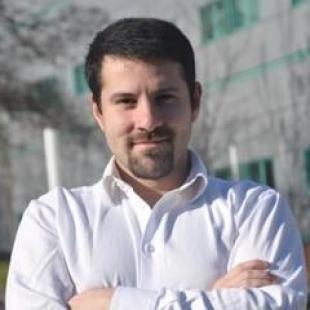Post date:
When doing tasks we are often confronted with a fundamental question: shall I do it fast or do it precisely? From experience we know that achieving both is exceedingly difficult; compromise is the best bet. But can speed and precision be maximised at the same time? A new study from Dr. Filippo Menolascina, Chancellor’s Fellow in the Institute for BioEngineering and PI at the Centre for Systems and Synthetic Biology, suggests that there is a way to do so and, even more interestingly, marine bacteria can teach us how.
While studying chemotaxis, the ability of microorganisms to seek nutrients in their environment and accumulate towards food ‘hotspots’, Filippo and his collaborators have discovered that a species of marine bacteria, Vibrio alginolyticus (a close relative of the bacterium that causes cholera), can dynamically alter its ‘swimming style’ to (a.) arrive at a nutrient source faster and, once there, (b) precisely identify the exact location and pack more tightly to the hotspot.
“The ocean is meager place,” says Filippo says. “Feeding often means waiting for algae to burst or marine ‘snow’ to pass by: relatively rare events that often last only a few tens of seconds before the nutrients disperse away. Being able to exploit them makes the difference between life and death.” The question is then how bacteria solved this problem. Filippo has found that there are two ingredients to success: (a) you need to get there before the others and (b) once there, you need to get the most out of it, i.e. you need to continuously track where the food hotspot is.
Swimming fast seems a good idea, but it will only help you get to the hotspot first. If you are very fast you can overshoot and effectively squander your advantage. Not a wise thing to do, also considered that speeding up is extremely expensive: increasing the swimming speed by a factor of two costs a cell four times as much energy.
Cells, at the microscale, are confronted with complex problems too: how can they make sure they arrive first, eat as much as they can and not waste energy in the process? Filippo has discovered that they increase their swimming speed only when they sense nutrients around them and, when they get to the nutrient source, they backtrack their steps more frequently, irrespectively of whether they are going up or down a gradient of nutrients. “They basically developed their own strategy to use a special combination of the cellular counterparts of gas pedal and handbrake/reverse gear.” We can take inspiration from this strategy to build better engineered systems, from robots to synthetic cells, to effectively explore the environment.
Filippo used a combination of single-cell tracking of thousands of marine bacteria in microfluidic gradients and developed a new mathematical model of chemotaxis that explicitly accounts for swimming speed in the chemotaxis pathway.
His work provides closure on the long-standing question of why marine bacteria often swim so fast. In a resource-poor environment, speed not only helps them get there faster but they can retain ‘pole position’ for longer. This new understanding will help us better understand the ecological role of bacteria in important marine microbial processes such as the utilization of dissolved organic matter to the infection of coral reefs.
The research is published in the Proceedings of the National Academy of Sciences USA.
Further Information
- "Speed-dependent chemotactic precision in marine bacteria", PNAS vol. 113 no. 31
- University of Edinburgh Press Release: "Ocean bugs inspire smart therapies quest"
- Eureka Alert: Marine bacteria Vibrio alginolyticus magnified several thousand times
- Dr Filippo Menolascina
- Institute for Bioengineering (IBioE)
- SynthSys, Centre for Synthetic and Systems Biology



